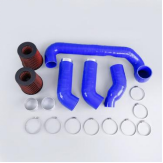In recent years, more and more materials have been used in automobile intake pipes, such as carbon fiber, aluminum, titanium and silicone. Today we will talk about why silicone intake pipes are becoming more and more popular.And more and more people choose to customize.



1. Durability and long life
One of the main reasons for the popularity of silicone air intake ducts is their durability. The silicone material can withstand extreme temperatures, ranging from -50°C to 200°C, making it ideal for the high-temperature environments commonly found in engine bays. This resistance to extreme temperatures ensures a longer lifespan compared to other materials that may degrade over time.
2. Corrosion and Chemical Resistance
Silicone intake pipe are not only heat resistant; they also exhibit excellent resistance to corrosion and chemicals. This property is critical in environments where the duct may come in contact with a variety of fluids, such as oil, fuel, or other automotive fluids. This resistance protects the integrity of the duct and ensures consistent performance.
3. Vibrant Color Options and Aesthetics
Silicone intake pipe are available in a variety of colors, allowing for customization and a more personalized look under the hood. The bright colors not only add visual appeal, but also make it easier to identify and inspect the duct during maintenance.
4. High Efficiency and Flow Characteristics
Silicone intake pipe can maintain a consistent inner diameter throughout the system, helping to reduce turbulence and improve airflow. This feature is especially important in performance applications where every bit of horsepower counts.
5. Easy Installation and Maintenance
They can be easily bent and formed to fit a variety of configurations, reducing the need for custom fabrication. In addition, their smooth surface makes cleaning and inspection a breeze
6. Versatility and Customization
Silicone air intake pipe are extremely versatile and can be customized to suit a variety of applications. Please contact Jagrow for custom silicone hose requirements.














